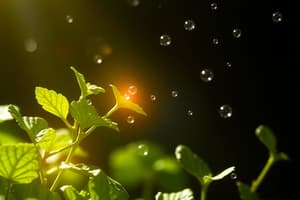Podcast
Questions and Answers
What is the main function of chlorophyll in photosynthesis?
What is the main function of chlorophyll in photosynthesis?
- Produces glucose
- Regenerates NADPH
- Generates oxygen
- Absorbs light energy (correct)
During photosynthesis, what is the role of ATP synthase enzyme?
During photosynthesis, what is the role of ATP synthase enzyme?
- Aids in carbon fixation
- Produces oxygen
- Creates ATP (correct)
- Generates NADPH
- Converts CO2 to glucose
Where does the Calvin cycle take place in a chloroplast?
Where does the Calvin cycle take place in a chloroplast?
- Grana
- Stroma (correct)
- Thylakoids
- Envelope
What is the primary source of energy for plants and other organisms resulting from photosynthesis?
What is the primary source of energy for plants and other organisms resulting from photosynthesis?
Which process is responsible for the regeneration of NADP+ during the Calvin cycle?
Which process is responsible for the regeneration of NADP+ during the Calvin cycle?
What is the function of the grana in a chloroplast?
What is the function of the grana in a chloroplast?
What is the primary energy carrier in living things?
What is the primary energy carrier in living things?
Where in the plant cell does photosynthesis primarily occur?
Where in the plant cell does photosynthesis primarily occur?
What pigment found in thylakoids absorbs light energy for photosynthesis?
What pigment found in thylakoids absorbs light energy for photosynthesis?
What is the function of grana in a chloroplast?
What is the function of grana in a chloroplast?
Which structure in a chloroplast is responsible for the production of carbohydrates?
Which structure in a chloroplast is responsible for the production of carbohydrates?
What is the term for an organism that produces its own food using light energy?
What is the term for an organism that produces its own food using light energy?
Flashcards are hidden until you start studying
Study Notes
Photosynthesis: The Process by Which Plants Produce Food and Oxygen
Introduction
Photosynthesis is a vital process of converting sunlight into chemical energy that powers most life on Earth. It is a light-driven process that occurs primarily in the chloroplasts of plant cells. This article will discuss the main components of photosynthesis, including the stages, the role of chloroplasts, and the ecological importance of this essential process.
Key Terms and Components
- Photosynthesis: The process by which plants, algae, and some bacteria convert light energy to chemical energy in the form of sugars.
- Photoautotroph: An organism that produces its own food using light energy, like plants.
- ATP: Adenosine triphosphate, the primary energy carrier in living things.
- Chloroplast: The plant cell structure where photosynthesis occurs.
- Thylakoids: Disc-like structures within a chloroplast that help absorb light.
- Grana: Stacks of thylakoids in a chloroplast.
- Chlorophyll: A pigment found in the thylakoid that absorbs light energy and uses it to produce carbohydrates.
- Stroma: The fluid-filled space surrounding the grana.
Stages of Photosynthesis
Photosynthesis is divided into two main stages: the light-dependent reactions and the Calvin cycle (also called the Calvin–Benson cycle).
Light-Dependent Reactions
The light-dependent reactions occur in the thylakoid membrane and involve the following steps:
- Light energy absorption: Chlorophyll within the thylakoids absorbs light energy.
- Generation of ATP: The absorbed light energy is used to create ATP (adenosine triphosphate) via the ATP synthase enzyme.
- Generation of NADPH: Another electron transport chain in the thylakoids generates NADPH (nicotinamide adenine dinucleotide phosphate) from NADP+ (nicotinamide adenine dinucleotide phosphate).
These reactions require sunlight and are directly linked to the light-independent reactions.
Calvin Cycle (Calvin–Benson Cycle)
The Calvin cycle occurs in the stroma and involves the following steps:
- Carbon fixation: CO2 (carbon dioxide) is fixed into an organic compound using ATP and NADPH.
- Reduction of glyceraldehyde 3-phosphate (G3P): The organic compound is then reduced to glyceraldehyde 3-phosphate (G3P).
- Phosphorylation of G3P: G3P is phosphorylated to form glucose-6-phosphate (G6P) and fructose-6-phosphate (F6P).
- Splitting and regeneration: G6P and F6P are split into glucose and fructose by an enzyme called aldolase. The NADPH generated during the Calvin cycle is used to regenerate NADP+, which can then enter the Calvin cycle again.
Chloroplast Structure and Function
Chloroplasts are organelles within plant cells that are responsible for photosynthesis. They have a complex structure:
- Envelope: The outermost layer of the chloroplast, consisting of two membranes that do not participate in photosynthesis.
- Stroma: The fluid-filled space surrounding the grana, where the Calvin cycle takes place.
- Thylakoids: Disc-like structures within the chloroplast, containing chlorophyll and other pigments that absorb light.
- Grana: Stacks of thylakoids, where the light-dependent reactions occur.
Ecological Importance
Photosynthesis is crucial for ecosystems and Earth's life support systems. It provides:
- Oxygen: Plants release oxygen during photosynthesis, which is essential for the survival of most living organisms.
- Food: The glucose produced during photosynthesis serves as a primary source of energy for plants and other organisms.
- Fixed carbon: Carbon from CO2 can be incorporated into organic molecules, providing essential carbon for other organisms.
Conclusion
Photosynthesis is a vital process that sustains life on Earth by converting sunlight into chemical energy. It is driven by light and occurs in the chloroplasts of plant cells, involving a series of light-dependent and light-independent reactions. The ecological importance of photosynthesis cannot be overstated, as it provides essential oxygen, food, and fixed carbon for ecosystems.
Studying That Suits You
Use AI to generate personalized quizzes and flashcards to suit your learning preferences.




